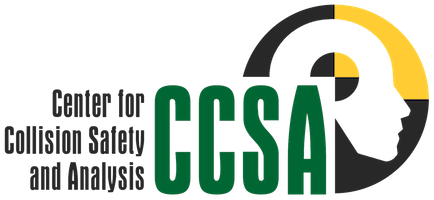The Center for Collision Safety and Analysis (CCSA) at George Mason University brings together a strong and richly experienced team of scientists and engineers focused on using advanced technology to understand collisions involving transport vehicles and to develop means to avoid or mitigate them to enhance safety and security. CCSA is associated with the College of Science at George Mason University and the National Center for Manufacturing Science (NCMS).
Collision Safety & Analysis
Collision Safety and Analysis is about understanding events where objects collide or crash, the nature of the impacts, correlations to outcomes, and potentials for mitigating the consequences. For example, when vehicles on the road collide, there is risk of injury/death to the occupants of the vehicles, deformation of the vehicles, redirection of vehicles into other traffic, and/or damage to elements of the highway infrastructure.
Safety analysis involves evaluating the crash energy from an impact at a given angle and speed, the distribution of impact forces, the dynamic tolerances of the occupants or hardware, and design features to absorb or dissipate the crash energy of the vehicle and the highway infrastructure. Concepts of physics, materials science, biomechanics, and engineering supported by high-performance computer tools provide the basis for various types of safety analyses related to collisions.
The analyses can involve any type of vehicle or components thereof. For example, the same advanced computational methods used to analyze the impact between vehicles on the road can be applied to analyze the consequences of a ruptured fan blade ejected from a jet engine on the occupants of an airliner.
Collision analyses also applies to efforts to enhance security by preventing damage to critical elements of the transportation infrastructure or thwarting intrusions into building or other facilities. The members of the CCSA Team have undertaken research on these topics and others and stand ready for other challenges to make transportation safer and more secure.
Mission
The mission of the Center for Collision Safety and Analysis is to advance collision safety though scientific research using sophisticated computational methods that provide a means to establish a sounder understanding of collision dynamics, likely effects on the users, vehicles, and infrastructure system elements, and potential effectiveness of mitigation options.
This understanding allows for better design, analysis, evaluation and deployment of means to mitigate collision effects across a broad spectrum of impact conditions, vehicle types, design features, technological options, and environmental conditions.
Goals & Objectives
The overriding mission of the CCSA is to advance the knowledge and technologies for collision analysis for transportation safety/security, to train the next generation of professionals in collision analysis, and to provide a forum for collaboration between the government, industry, and academia to enhance transportation safety and security. The objectives of the CCSA program include:
- Conduct advanced research to assist researchers and engineers in resolving transportation safety and security issues by expanding knowledge about crashes and the means to mitigate adverse outcomes.
- Develop and validate detailed finite element vehicle and hardware models to support advanced computational methods and lead efforts to apply these models in computer simulation tools to study the complex interactions associated with collisions.
- Advance the application of science and advanced computational methods for collision safety and analysis across all aspects of transportation.
- Support a repository for collision analysis information including crash test films, analyses documentation, models, and simulation results.
- Conduct impact testing to validate computer models and produce relevant data for crash analysis to improve highway and vehicle safety.
- Promote broad approach toward recognizing current and emerging safety and security issues and the potential insights and solutions that can be generated through Collision Safety and Analyses.
- Collaborate with the NCMS and other centers to support advanced research and product design and advancement of tools and methods for extended capabilities to address safety and security issues.
- A key facet of the CCSA Mission will be the sharing of findings, data, models, and technologies to expedite efforts to address complex safety problems. The CCSA team brings to Mason decades of experience and numerous accomplishments in the safety field.
Focus
The focus of the Center will initially be on Highway and Vehicle Safety as more than 37,000 fatalities and an estimated 3.144 million people were injured
in the United States in 2016. This constitutes one of the greatest public health and societal concerns in the country.
These numbers have remained high despite concerted efforts to regulate vehicle designs, build safe roads, train drivers, enhance risk awareness, enforce traffic laws, and require crashworthy road hardware. This safety problem is global with considerably higher numbers of fatalities and injuries in other parts of the world.
While serious strides are being made in crash avoidance and other technologies that will promote safety, widespread deployment will take decades and the need for collision safety and analysis will still exist for the vehicle and highway designs to be “fail safe.” Collision safety issues also are common to other modes of transportation and analysis methods are applicable.
Security is an extension of safety that has also been addressed by collision analysis. Advanced computational methods have been used to determine the requirements for anti-ram barriers to protect buildings and other facilities.
Terms of Service
Privacy statement for the Center for Collision Safety and Analysis
- Our website does not collect any personal information from users.
- Visits are logged for aggregate statistics and diagnosis.
- We do not use cookies or any other tracking technology.
- Security settings protect the misuse of sensitive information.
